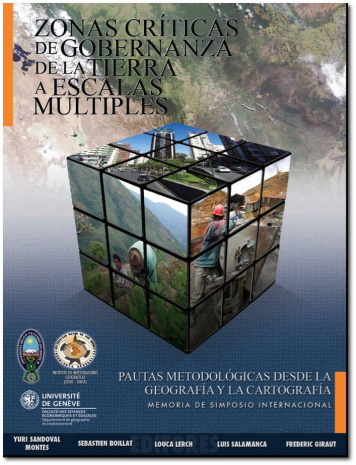BOLAO
A multi-scale approach to land governance in complex cultural, environmental and institutional contexts. Development of a comparative GIS methodology linking land use, land cover and land tenure from the cases of Bolivia and the Lao PDR (BOLAO)
Are pressures on land concentrated on "hotspots"? Do these pressures lead to frictions and conflicts among land users and stakeholders?
This project, financed by the Swiss Network for International Studies, has the objective of understanding land governance in terms of its spatial expression across multiple scales by assessing the interactions between local social-ecological systems and overarching governance configurations.
It was carried out by the Department of Geography and Environment of the University of Geneva (Switzerland) under the direction of Prof. Frédéric Giraut and Dr. Sebastien Boillat, in collaboration with the Instituto de Investigaciones Geográficas (IIGEO) (Dr. Yuri Sandoval)of the Mayor de San Andrés University of La Paz (Bolivia), and the Faculty of Forestry of the National University of Laos (Dr. Sithong Thongmanivong) in Vientiane (Lao PDR).
See complete list of project's members on SNIS web site.
Main results
The kick-off symposium of the project was held in La Paz, Bolivia, in March 2012.
23 Contributions were published in a book Zonas Criticas de la Gobernanza de la Tierra a Escalas Múltiples [in Spanish].
Forest cover change and socio-economic drivers
We assessed relationships between population density, poverty, ethnicity, accessibility and forest cover change during the last decade for four regions of Bolivia and the Lao PDR. Accessibility is a key driver of forest cover change, yet it has the effect of intensifying other economic and policy-related underlying drivers, like colonization policies, cash crop demand, but also policies that lead to forest gain in one case. These results were used to elaborate a typology of social-ecological systems, and discussing their possible outcomes in light of a critical view on forest transition theory. See the full article published in Land.
National land policies and land cover change
- Are commons more remote? Land policy, accessibility and forest cover change in Bolivia.
We tested the hypothesis formulated by Bottazzi and Dao (2013) that in Bolivia, forest in common lands is less converted than in private lands, mainly because common lands are located further away from roads. Publication of this study’s results is in progress.
- Resettlements, population, land access and forest cover change in the Lao PDR.
We assessed the relationships between relocation of villages and land use planning on forest cover change in the Lao PDR through a multi-scale approach. A Master’s thesis (Corinna Stich) was successfully accomplished on a case study in Luang Prabang. Publication of this study’s results is in progress.
Transnational land governance: the geopolitics of development interventions in Bolivia and Lao PDR
- Approaching geopolitical land governance hotspots from land survey funding data
This contribution, published in the Journal of Latin American Geography by Louca Lerch, analyzed the Bolivian INRA land survey database to assess where international stakeholders of land surveying funding had focused their interests. This analysis was completed with participative observation and semi-directed interviews with key informants active within international aid system and Bolivian public administration, and led to the identification of four geopolitical land hotspots.
- Geocoding development interventions in Lao PDR
This study in progress the objective to assess the geography of foreign development interventions in the Lao PDR by geocoding their activities down to the village level, using the Ministry of Planning and Investment and Ministry of Agriculture and Forests databases
Frictions over land resources: trade-offs and conflict assessments
- Are land management conflicts predictable? An empirical approach to “land governance hotspots” in Bolivia
A geo-coded database on land conflicts based on press articles compiled by the Centro de Documentación e Información Bolivia (CEDIB) was assessed in relation with the diversity of land uses and productive potentials. Publication of this study’s results is in progress
- Exploring land use trade-offs: rubber plantations and tourism in Luang Namtha
This case study, published as Matthieu Guntern’s Master Thesis, looked at the impact of land use changes, especially the “rubber boom” on local livelihoods and tourism activities in the province of Luang Namtha
Mapping local knowledge and cultural heritage at the meso-scale: a reflection on risks and opportunities
A literature review about GIS and knowledge, mapping and indigenous knowledge, and GIS and cultural heritage was performed by Sarah-lan Mathez-Stiefel to assess opportunities and challenges in representing local knowledge and cultural heritage geographically at scales that go beyond the local.
More results:



